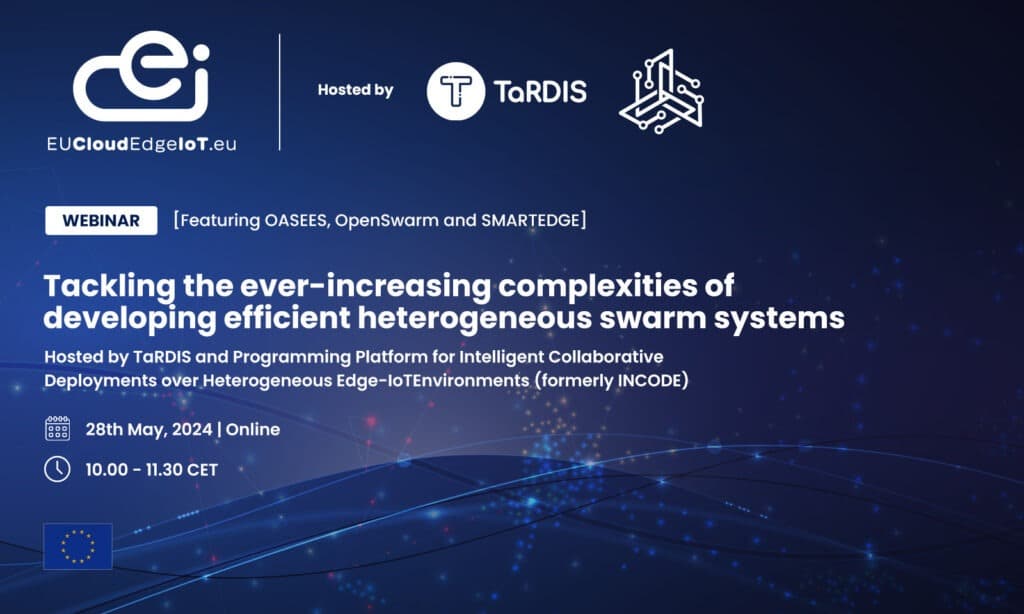On 28th May 2024, TaRDIS together with INCODE organised a webinar on “Tackling the ever-increasing complexities of developing efficient heterogeneous swarm systems”, involving all 5 projects of the Swarm computing cluster of the European Cloud Edge IoT ecosystem.
In the context of the “EUCloudEdgeIoT.eu RIA Showcase” organised by the Open Continuum CSA, to present cutting-edge results and advancements in the Cloud-Edge-IoT Computing Continuum, the Horizon Europe Framework-funded projects TaRDIS and Programming Platform for Intelligent Collaborative Deployments over Heterogeneous Edge-IoTEnvironments (formerly INCODE) co-organised a webinar to compare standpoints, achievements and recommendations among the swarm computing-focused projects operating under the EUCloudEdgeIoT umbrella.

The context
As Europe creates a pathway for the understanding and development of the Cloud, Edge and IoT Continuum and supporting research and innovation initiatives to develop applications across the continuum, the paradigm also incorporates development of swarm and decentralized applications. In edge computing scenarios where there is a need for decentralized decision-making and coordination among edge devices, swarm computing principles can be applied; such a decentralized and self-organizing concept and architecture fit particularly well hyper-distributed, sovereignty-enabling, heterogeneous data management challenges, such as the ones found in European Data Spaces. Additionally, edge devices can act as agents in a swarm, collectively making decisions and adapting to changing conditions without relying on a central controller. This session, brought together the 5 Horizon Europe projects answering to the swarm computing call and addressing the ever-increasing complexities of developing correct and performant heterogeneous swarm systems.
The projects on the virtual stage
The project Programming Platform for Intelligent Collaborative Deployments over Heterogeneous Edge-IoTEnvironments (formerly INCODE) enables an open and trusted cloud-native programming platform poised to tame the emerging dynamism of distributed and heterogeneous private edge infrastructures (seen as a combination of intelligent edge node and diverse types of smart IoT devices with processing capabilities over programmable data plane resources). Representing the project in this discussion is John Avramidis (Unisystems).
The TaRDIS project, represented by Dr. Carla Ferreira (Nova School of Science and Technology, Portugal and Coordinator of the project), addresses the ever-increasing complexities of developing correct and performant heterogeneous swarms by providing a novel programming model, integrated development and analysis environment, and corresponding runtime support. TaRDIS proposes a language-independent event-driven programming model that allows developers to specify the behaviour of different components in their distributed system as a collection of autonomous collaborative nodes.
The OASEES project will deliver a European, fully open-source, decentralized, and secure Swarm programmability framework for edge devices and leveraging various AI/ML accelerators (FPGAs, SNNs, Quantum) while supporting a privacy-preserving Object ID federation process. Akis Kourtis (National Centre for Scientific Research “Demokritos”, Greece) presented on behalf of OASEES.
The ambition of OpenSwarm project is to enable novel, future energy-aware swarms of collaborative smart nodes with wide range benefits for the environment, industries, and society. Presenting OpenSwarm was Thomas Watteyne from INRIA, France.
The SMARTEDGE project, which was represented at the webinar by Danh Le-Phuoc (TU Berlin), aims to enable decentralised edge intelligence for smart IoT applications, ensuring reliability, security, privacy, and scalability. This is achieved through the innovative SmartEdge tool-chain for autonomous intelligent swarms, featuring real-time semantic integration, discoverability, and composability.
Discussion summary
After the introductory speech of Albert Seubers (EUCloudEdgeIoT.eu, Martel Innovate BV), who also moderated the discussion, the presenters discussed the latest advancements in the development of swarm computing systems. The major topics addressed how new innovations are seeking to improve the efficiency and scalability through new types of algorithms, communication protocols and integration techniques. Building heterogeneous swarm systems will increase the performance and adaptability so that a greater resilience can be achieved. When it comes to key challenges in that regard, the panellists stressed the need to ensure interoperability by enforcing robust standards and protocols for a seamless communication and coordination between systems. Scalable solutions would enable this so that latency can be reduced and resource allocation can be optimised. Enhanced collaborations and prioritising research and development in AI, machine learning and edge computing is therefore key.
The presentations also showcased a number of real-world use cases in sectors such as agriculture for crop monitoring, environmental monitoring for pollution levels, and disaster response in search and rescue operations. The webinar provided an excellent opportunity to explore the current state and future directions of swarm computing. It highlighted the need for interoperability, scalability, and efficient resource management while showcasing practical applications and the critical role of collaboration in driving innovation. The discussions emphasised the potential of swarm computing to address complex real-world problems through coordinated, intelligent systems.
Key insights
The webinar explored the current state and future of swarm computing developments along with its challenges. It highlighted the need for interoperability, scalability, and efficient resource management while showcasing practical applications and the critical role of collaboration in driving innovation.
The webinar attracted an audience of over 100 stakeholders, connecting from 17 countries
Access the webinar resources
For those who missed the live session, the webinar recording is now available here below:
